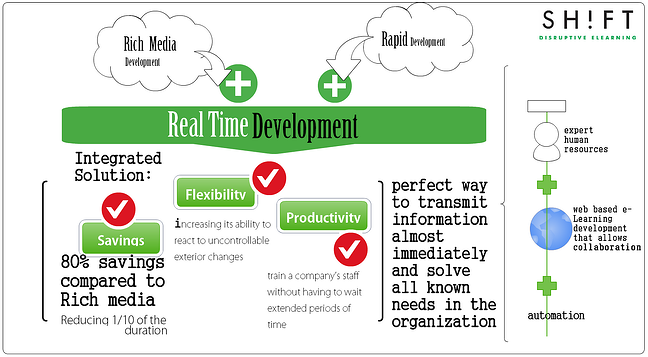
There’s a formula called Real Time Development and it is mainly based in real time content development. This formula seeks to break current paradigms and transform the actual process into the new way of creating eLearning.
Real Time Development aims to complement and improve results of current trends in eLearning Rich Media Development aside from supplying a need that hasn’t currently been met: developing and spreading knowledge as it surfaces.
Rich Media Development is one of many traditional processes in the eLearning industry, it is mainly characterized because it requires a broad budget and a long development schedules when developing an eLearning product.
To meet the requirements of those organizations in need of shorter development terms out came Rapid Development.
This modality lets people create eLearning content in a simpler way which is less expensive and takes less development time, this helped solve the company’s demands for a while; nonetheless, companies came back needing an integrated solution, that’s where Real Time Development was born.
Its main advantage relies on a triangle based work form whose vortexes are made up of three main benefits: savings, flexibility and productivity.
-
Real time development can be as significant as up to 80% of cost related savings when compared to Rich Media Development, reducing one tenth of the duration.
-
Also, the short development time required provides the organization with a great deal of flexibility, increasing its ability to react to uncontrollable exterior changes, like modifications to policies and processes or increasing or decreasing market’s demands which requires short term decisions to be made on a daily bases.
-
Having the ability to train a company’s staff without having to wait extended periods of time and with content that’s current allows everyone to increase productivity. Once the area or process where knowledge takes a vital role is identified, Real Time Development becomes the perfect way to transmit information almost immediately and solve all known needs in the organization.
In order to transform this proposal into something that’s tangible you’ll need automation. Automating repetitive stages in eLearning development lets you change the focus of your collaborators from unnecessary processes into essential activities like instructional design.
All organizations as well as the service’s provider need to have expert human resources with decision making skills and power that can act as quickly as required. Also, it is very important to have a web based eLearning development platform that allows collaborative work and that can dramatically simplify and automate the process.
In a world that’s becoming more and more competitive by the day and where organizations are becoming more dynamic, there’s a need to cross all known limits and democratize knowledge.
Are you willing to do it? The time is now! 2012 provides the eLearning industry with an opportunity to evolve toward a common goal which is Real Time Development.









